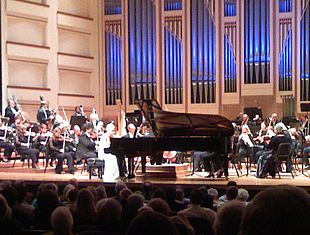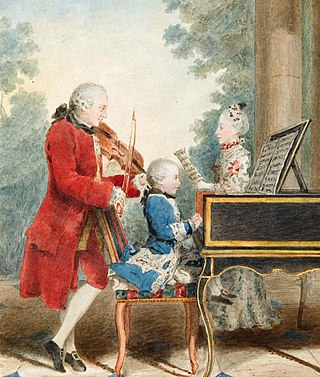
The Classical Period was an era of classical music between roughly 1750 and 1820.
A concerto is, from the late Baroque era, mostly understood as an instrumental composition, written for one or more soloists accompanied by an orchestra or other ensemble. The typical three-movement structure, a slow movement preceded and followed by fast movements, became a standard from the early 18th century.

Carl Czerny was an Austrian composer, teacher, and pianist of Czech origin whose music spanned the late Classical and early Romantic eras. His vast musical production amounted to over a thousand works and his books of studies for the piano are still widely used in piano teaching. He was one of Ludwig van Beethoven's best-known pupils and would later on be one of the main teachers of Franz Liszt.

The Piano Concerto No. 5 in E-flat major, Op. 73, known as the Emperor Concerto in English-speaking countries, is a piano concerto composed by Ludwig van Beethoven. Beethoven composed the concerto in 1809 under salary in Vienna, and he dedicated it to Archduke Rudolf, who was his patron, friend, and pupil. Its public premiere was on 28 November 1811 in Leipzig, with Friedrich Schneider as the soloist and Johann Philipp Christian Schulz conducting the Gewandhaus Orchestra. Beethoven, usually the soloist, could not perform due to declining hearing.
A harpsichord concerto is a piece of music for an orchestra with the harpsichord in a solo role. Sometimes these works are played on the modern piano. For a period in the late 18th century, Joseph Haydn and Thomas Arne wrote concertos that could be played interchangeably on harpsichord, fortepiano, and pipe organ.

Beethoven's Piano Concerto No. 3 in C minor, Op. 37 is generally thought to have been composed in 1800, although the year of its composition has been questioned by some contemporary musicologists. It was first performed on 5 April 1803, with the composer as soloist. During that same performance, the Second Symphony and the oratorio Christ on the Mount of Olives were also premiered. The composition was published in 1804, and was dedicated to Prince Louis Ferdinand of Prussia. The first primary theme is reminiscent of that of Mozart's 24th Piano Concerto.

Felix Mendelssohn's Violin Concerto in E minor, Op. 64, MWV O 14, is his last concerto. Well received at its premiere, it has remained among the most prominent and highly-regarded violin concertos. It holds a central place in the violin repertoire and has developed a reputation as an essential concerto for all aspiring concert violinists to master, and usually one of the first Romantic era concertos they learn. A typical performance lasts just under half an hour.
Sinfonia concertante is an orchestral work, normally in several movements, in which one or more solo instruments contrast with the full orchestra. It emerged as a musical form during the Classical period of Western music from the Baroque concerto grosso. Sinfonia concertante encompasses the symphony and the concerto genres, a concerto in that soloists are on prominent display, and a symphony in that the soloists are nonetheless discernibly a part of the total ensemble and not preeminent. Sinfonia concertante is the ancestor of the double and triple concerti of the Romantic period corresponding approximately to the 19th century.
The organ repertoire is considered to be the largest and oldest repertory of all musical instruments. Because of the organ's prominence in worship in Western Europe from the Middle Ages on, a significant portion of organ repertoire is sacred in nature. The organ's suitability for improvisation by a single performer is well adapted to this liturgical role and has allowed many blind organists to achieve fame; it also accounts for the relatively late emergence of written compositions for the instrument in the Renaissance. Although instruments are still disallowed in most Eastern churches, organs have found their way into a few synagogues as well as secular venues where organ recitals take place.
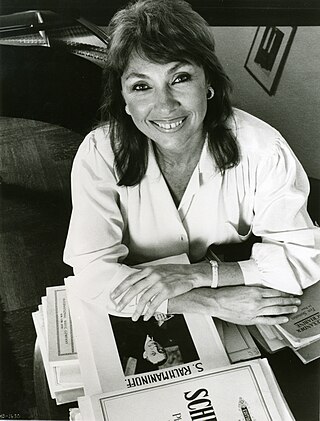
Ruth Laredo was an American classical pianist.
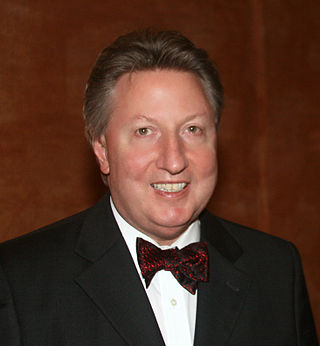
Leslie John Howard is an Australian pianist, musicologist and composer. He is best known for being the only pianist to have recorded the complete solo piano works of Franz Liszt, a project which included more than 300 premiere recordings. He has been described by The Guardian as "a master of a tradition of pianism in serious danger of dying out".
Yeol Eum Son is a world renowned South Korean classical pianist. She is particularly esteemed as an interpreter of the Classical era of composers, especially Haydn, Mozart, Beethoven, as well as such later composers as Mendelssohn, Schumann, Liszt, Rachmaninoff and Ravel. Son regularly performs as soloist with prominent orchestras and eminent conductors.

Sandro Ivo Bartoli is an Italian pianist.

Wolfgang Amadeus Mozart's concertos for piano and orchestra are numbered from 1 to 27. The first four numbered concertos and three unnumbered concertos are early works that are arrangements of keyboard sonatas by various contemporary composers. Concertos 7 and 10 are compositions for three and two pianos respectively. The remaining twenty-one are original compositions for solo piano and orchestra. These works, many of which Mozart composed for himself to play in the Vienna concert series of 1784–86, held special importance for him.

Vox Records is a budget classical record label. The name is Latin for "voice."
A solo concerto is a musical form which features a single solo instrument with the melody line, accompanied by an orchestra. Traditionally, there are three movements in a solo concerto, consisting of a fast section, a slow and lyrical section, and then another fast section. However, there are many examples of concertos that do not conform to this plan.
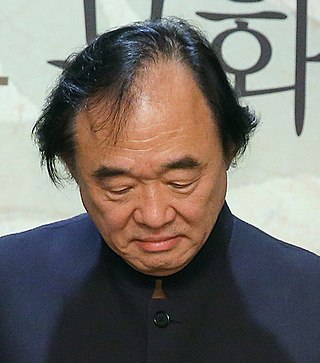
Kun-woo Paik is a South Korean pianist. He has performed with multiple orchestras, including the London Symphony Orchestra, the BBC Symphony Orchestra, and the Saint Petersburg Philharmonic.
Olli Mustonen is a Finnish pianist, conductor, and composer.

Brilliant Classics is a classical music label based in the Dutch town of Leeuwarden. It is renowned for releasing super-budget-priced editions on CD of the complete works of J.S. Bach, Mozart, Beethoven and many other composers. The label also specialises in new recordings of early music, chamber, organ and piano music.
